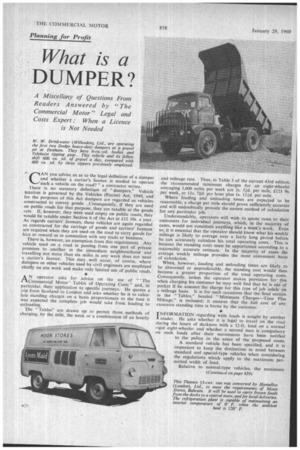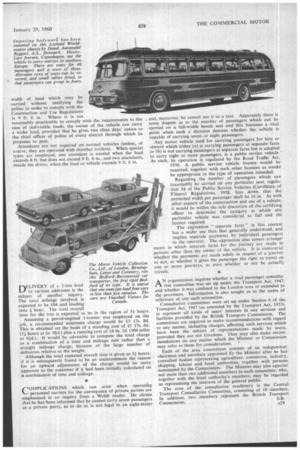What is a DUMPER?
Page 60

Page 63

If you've noticed an error in this article please click here to report it so we can fix it.
" AN you advise us as to the legal definition of a dumper and whether a carrier's licence is needed to operate such a vehicle on the road?" a contractor writes.
There is no statutory definition of "dumpers." Vehicle taxation is governed by the Vehicles (Excise) Act, 1949, and for the purposes of this Act dumpers are regarded as vehicles constructed to convey goods. Consequently, if they are used on public roads for that purpose, they are taxable at the goods rate. If, however, they were used empty on public roads, they would be taxable under Section 6 of the Act at £.12 10s. a year. As regards carriers' licences, these vehicles are again regarded as constructed for the carriage of goods and carriers' licences. are required when they are used on the road to carry goods for hire or reward or in connection with any trade or business.
There is, however, an exemption from this requirement. Any vehicle used on a road in passing from one part of private premises to another in the immediate neighbourhood • and travelling not more than six miles in any week does not need a carrier's licence. This may well occur, of course, where dumpers or other vehicles used by civil engineers are employed chiefly on site work and make only limited us t of public roads.
AN operator asks for advice on the use of " ' The Commercial Motor' Tables of Operating Costs" and, in particular, their application to specific journeys. He quotes a air, from Scotland to London and asks whether he is to calculate standing charges on a basis proportionate to the time it was expected the complete job would take from loading to unloading.
The "Tables" are drawn up to permit three methods of charging, by the mile, the week or a combination of an hourly and mileage rate. Thus, in Table 3 of the current 43rd edition. the recommended minimum charges for an eight-wheeler averaging 1,000 miles per week are 2s. 51d. per mile, £121 9s. per week, or I Is. 7d. per hour plus Is. 1 lid. per mile.
Where loading and unloading times are expected to be reasonable, a charge per mile should prove sufficiently accurate and will undoubtedly provide the easiest method of calculation for any particular job. • Understandably, operators will wish to quote rates to their customers for individual journeys, which, in the majority of cases, would not 'constitute anything like, a week's work. Even so, it is essential that the operator should know what his weekly mileage is likely, to average over a fairly long period before he can accurately calculate his total operating costs. This is because the standing costs must be apportioned according to a reasonably accurate estimate. In the majority of cases the average weekly mileage provides the most convenient basis of calculation.
• When, however, loading and unloading times are likely to be abnormal or unpredictable, the standing cost would then become a greater proportion of the total operating costs. Consequently, unless the operator makes provision forthis when charging his customer he may well find that he is out of pocket if he assessesthe charge for this type ofjob solely On a mileage basis. It is for such occasions that the final section in the "Tables," headed "Minimum Charges—Time Plus Mileage," is included; it ensures that the full cost of any, excessive standing time is borne by the customer.
' N FORMATION regarding wide loads is sought by another reader. He asks whether it is legal to travel on the road during the hours of darkness with a 12-ft. load on a normal rigid eight-wheeler and whether a second man is compulsory on such loads after their movements have been notified to the police in the areas of the proposed route.
A standard vehicle has been specified, and it is important to keep the distinction in mind between standard and special-type vehicles when considering the regulations which apply to the maximum permitted width of load.
Relative to normal-type vehicles, the maximum (Continued on page 859) width of load which may be carried without notifying the police in order to comply with the Construction and Use Regulations is 9 ft. 6 in. Where it is not reasonably practicable to comply with the requirements in the case of indivisible loads, the owner of the vehicle can carry a wider load, provided that he gives two clear days' notice to the chief officer of police of every district through which he proposes to pass.
Attendants are not required on normal vehicles (unless, of , course, they are operated with drawbar trailers). When special types arc employed, one attendant is needed when the load exceeds 8 ft. but does not exceed 9 ft. 6 in., and two attendants, beside the driver, when the load or vehicle exceeds 9 ft. 6 in.
nELIVERY of a 1-ton load
to various addresses is the subject of another inquiry. The total mileage involved is expected to be 104 and loading time 1 hour. The total overall time for the trip is expeoted to be in the region of 51 hours.
Assuming a petrol-engined 1-tonner was employed on the job, a recommended minimum charge would be £5 17s. 8d. This is obtained on the basis of a standing cost of £1 17s. 6d. (5/ hours at 6s. 9td.) plus a running cost of £4 Os. Zd. (104 miles at 91d.). It would be advisable to compute the total charge as a combination of a time and mileage rate rather than a straight mileage charge, because of the large number of deliveries relative to the weight.
Although the total expected overall time is given as 5/ hours, if it is subsequently found to be an underestimate the reason for an upward adjustment of the charge would be more apparent to the customer if it had been initially calculated on a combination of time and mileage.
rIOMPLICATIONS which can arise when operating personnel carriers for the conveyance of private, parties are emphasized in an inquiry from a Welsh reader. He claims that he has been informed that he cannot carry seven passengers as a private party, as to do so is not legal in an eight-seater „ and, moreover, he cannot use it as a taxi. Apparently there is some dispute as to the number of passengers which can be carried on a full-width bench seat and this becomes a vital point when such a decision denotes whether the vehicle is capable of carrying seven or eight passengers.
Any motor vehicle used for carrying passengers for hire or reward which either (a) is carrying passengers at separate fares or (b) is not carrying passengers at separate fares but is adapted to carry eight or more passengers, is a public service vehicle. As such, its operation is regulated by the Road Traffic Act, 1930. A public service vehicle licence would he required, together with such other licences as would be appropriate to the type of operation intended. Regarding the number of passengers which can reasonably be carried on any particular seat, regulation 34 of the Public Service Vehicles (Certificate of Fitness) Regulations, 1958, lays down that the permitted width per passenger shall be 16 in. As with other aspects of the construction and use of a vehicle, it would be within the sole discretion of the certifying officer to determine the category in which any particular vehicle was considered to fall and the licence required.
The expression "separate fares" in this context has a wider use than that generally understood, and implies separate payments by individual passengers to the operator. The expression also covers arrangements in which separate fares for the journey are made to persons other than the owner of the vehicle. It is immaterial whether the payments are made solely in respect of a journey or not, or whether it gives the passenger the right to travel on one or more journeys, or even whether or not he actually travels.
AN organization inquires whether a road passenger consultative committee. was set up under the Transport Act, 1947, and whether it was conaned to the London area or extended to the provinces. Information is also sought as to the terms of reference of any such committee.
Consultative committees were set up under Section 6 of the. Transport Act, 1947 (as amended by the Transport Act, 1953), to represent all kinds of sers' interests in any services and facilities provided by the British Transport Commission. The committees are required to make recommendations with regard to any matter, including charges, affecting such services which have been the subject of representations made by users, provided they are not frivolous. They may also make recommendations on any matter which the Minister or Commission may refer to them for consideration.
Each of the area committees consists of an independent chairman and members appointed by the Minister after he has consulted bodies representing agriculture, commerce, industry, shipping, labour and local authorities, together with persons nominated by the Commission. The Minister may also appoint not more than two additional members to each committee, who, together with the local authority's members, may be regarded as representing the interests of the general public.
The core of the consultative machinery is the Central Transport Consultative Committee, consisting of 18 members. In addition, two members represent the British Transport Commission S.B.,






































































































